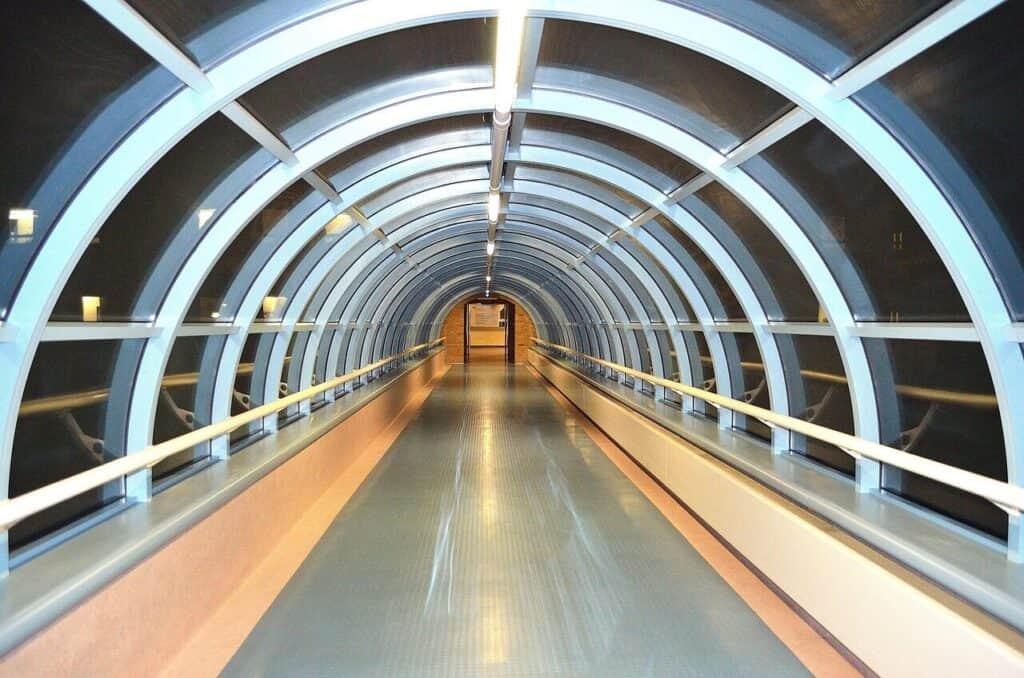The Engineer’s Guide to Cooling Tunnels: A Deep Dive into Technical Principles
Introduction: Beyond Industrial Cooling
A cooling tunnel is a key part of manufacturing processes. It’s designed to lower product temperature with precision and control. But it does much more than just chill things. It’s a complex system that relies on proven engineering principles.
How well any cooling tunnel works depends on three main areas working together. These are thermodynamics, fluid dynamics, and mechanical design. To reach a specific core temperature within a set time, you need to understand these fields deeply.
Isso guide gives process engineers a complete technical breakdown. We’ll start with the basic science of heat transfer. Then we’ll take apart the mechanical parts of a modern tunnel. We’ll also look at different cooling technologies you can choose from.
Finally, we’ll cover the key design factors, performance calculations, and control systems that make a cooling tunnel installation successful. You need to understand concepts like heat load and residence time. These are essential for specifying and running this equipment well.
The Core of Cooling: A Thermodynamic Breakdown
The main job of a cooling tunnel is to move heat around. It’s important to understand that cooling doesn’t add “cold” to something. Instead, it removes thermal energy from a product in a systematic and efficient way.
This energy removal happens through three different ways heat moves: conduction, convection, and radiation. One method usually does most of the work. But all three are present and help with the overall cooling process.
Conduction: Direct Contact Transfer
Conduction moves heat through direct physical contact. In a cooling tunnel, this mainly happens where the product bottom touches the conveyor belt.
How fast heat moves through conduction depends on several things. The thermal conductivity of the belt material matters. So does the product’s own conductivity and how much surface area touches the belt. While this is a factor, it’s often less important than convection unless you use a special conductive cooling belt.
Convection: The Cooling Workhorse
Forced convection does most of the heat transfer work in cooling tunnels. It uses moving cold fluid, usually air, flowing across the product’s surface.
Fans or blowers create this airflow. The moving air pulls heat from the product’s surface and carries it away to the refrigeration unit’s evaporator coil. How fast cooling happens depends on the temperature difference between the air and product, plus how fast the air moves.
Here’s a useful rule: doubling the air speed over a product can boost the convective heat transfer coefficient significantly. Often this increase ranges from 60-80%. This shows how powerful good airflow design is for tunnel performance.
Radiation: Invisible Energy Exchange
Radiative heat transfer exchanges energy through electromagnetic waves. The warmer product gives off thermal radiation. The colder interior surfaces of the tunnel enclosure absorb this radiation.
This method becomes more important as the temperature gap between the product and tunnel walls gets bigger. In cryogenic tunnels, where wall temperatures are extremely low, radiation plays a big role in overall heat removal.
Table 1: Comparative Analysis of Heat Transfer Modes in a Cooling Tunnel
Recurso | Condução | Convecção | Radiation |
Mecanismo primário | Direct molecular transfer (product-to-belt) | Heat carried away by fluid flow (air-over-product) | Electromagnetic wave emission (product-to-walls) |
Controlling Factors | Material thermal conductivity, contact area | Air velocity, air temperature, fluid properties | Surface emissivity, temperature difference (to the 4th power) |
Typical Contribution | Low to Moderate (highly dependent on product base) | High (Often 70-90% of total cooling) | Moderate (Increases with larger temperature differences) |
Optimization Método | Belt material selection, ensuring good product contact | Increasing fan speed, lowering air temperature | Painting interior walls a high-emissivity matte black |
Anatomy of a Modern Tunnel: Key Components
A cooling tunnel brings together mechanical and electrical parts into one system. You need to understand what each part does for proper specification, operation, and maintenance.
The Insulated Enclosure
The enclosure’s main job is creating a thermally separated environment. It stops ambient heat and moisture from getting into the process zone. This would increase the refrigeration load and reduce efficiency.
These enclosures are usually built from stainless steel panels filled with high-density polyurethane foam insulation. Panel thickness, joint design, and airtight sealing are key details. They determine the tunnel’s thermal integrity and hygienic performance.
The Conveyor System
The conveyor system moves the product through the tunnel at a precisely controlled speed. This directly sets the residence time.
Belt types vary widely based on what you’re making. Options include solid plastic, wire mesh, and modular plastic belts. The drive system almost always uses a variable frequency drive (VFD) motor. This allows precise speed control.
From our experience, choosing a VFD with a wide speed range is crucial for process flexibility. For delicate confectionery, a smooth ‘soft-start’ feature prevents product shifting during startup and shutdown cycles.
The Refrigeration & AHU
The refrigeration and air handling unit (AHU) is the heart of the cooling system. This unit chills the air and moves it throughout the tunnel enclosure.
It works on a standard vapor-compression cycle. This uses a compressor, condenser, expansion valve, and an evaporator coil. The evaporator coil is the part inside the AHU where the circulating air actually gets chilled.
Good design of the air distribution plenum and ducting is critical. The goal is delivering uniform, consistent airflow and temperature to the product across the entire width and length of the conveyor. This eliminates hot or cold spots.
The Control Panel (HMI/PLC)
The control panel is the brain of the tunnel. It lets operators set, monitor, and adjust all critical process parameters.
Modern systems have moved from simple thermostats and manual dials to sophisticated systems. These use Programmable Logic Controller (PLC) technology with a Human-Machine Interface (HMI) touchscreen.
This level of control enables precise and repeatable process settings for temperature, belt speed, and fan speed. This is essential for consistent product quality.
An In-depth Analysis of Cooling Technologies
How you apply cold air or a cold surface to the product is just as important as the temperature itself. The technology choice has major effects on cooling rates, product quality, and operating costs.
Forced Air Convection
Standard forced air convection is the most common and versatile cooling technology. It circulates a large volume of chilled air at relatively low speed throughout the tunnel.
This method is reliable and cost-effective. It works well for many products, from baked goods and snacks to confectionery and ready meals.
Air Impingement Cooling
Air impingement technology is a big step up in cooling intensity. It uses arrays of nozzles to aim high-speed jets of cold air directly at the product’s top and bottom surfaces.
The key idea here is breaking up the product’s insulating “boundary layer” of air. By cutting through this layer, impingement dramatically increases the convective heat transfer coefficient. This results in much faster cooling times compared to standard convection.
This technology is perfect for rapidly setting the surface of a product. Examples include crusting a chocolate coating or cooling flat items like cookies, pizza bases, and meat patties.
Indirect Conduction Cooling
Indirect conduction cooling doesn’t use air as the main medium. Instead, the product travels directly on a solid stainless steel or plastic belt that gets chilled from underneath by a circulating fluid, such as glycol or cold water.
This method provides intense and efficient cooling to the bottom of the product. It’s an excellent choice for liquids, slurries, or semi-solid products like sauces, purees, and confectionery fillings that can be spread in a thin layer.
Cryogenic Cooling (LN2 / CO2)
Cryogenic cooling uses the huge cooling capacity released during the phase change of liquid nitrogen (LN2) or carbon dioxide (CO2). Liquid nitrogen boils at -196°C (-320°F) and CO2 sublimates at -78.5°C (-109.3°F).
When sprayed into the tunnel, these cryogens instantly absorb massive amounts of heat from the product. This creates ultra-fast cooling or freezing. This is critical for preserving the cellular structure and quality of high-value products.
Applications include Individual Quick Freezing (IQF) of seafood and poultry, locking in moisture for cooked meat products, and chilling premium ready meals where quality is most important.
Table 2: Technical Comparison of Cooling Tunnel Technologies
Tecnologia | Cooling Rate | Capital Cost (CAPEX) | Operating Cost (OPEX) | Principais vantagens | Ideal Application |
Forced Air | Moderado | Baixa | Baixa | Simplicity, versatility | General purpose, bakery, confectionery |
Impingement | Alta | Médio | Médio | High-speed, uniform cooling | Flat products, surface crusting, par-baked goods |
Indirect | Moderate to High | Alta | Baixa | Excellent for liquids/slurries | Sauces, purees, confectionery fillings |
Cryogenic | Muito alta | Medium to High | Alta | Extreme speed, preserves quality | IQF seafood, high-value proteins, medical |
Critical Design Parameters and Calculations
Specifying or designing a cooling tunnel requires a structured engineering approach. Moving from product requirements to equipment specifications involves several critical calculations and design considerations. This serves as the engineering checklist for any new cooling project.
Calculating Total Heat Load
The total heat load is the total amount of thermal energy that the refrigeration system must remove per unit of time. It’s the single most important calculation in sizing a cooling tunnel. This load adds up several distinct parts.
- Product Load: This is the main load and represents the heat released by the product itself as it cools. You calculate it using the formula Q = m * c * ΔT, where ‘m’ is the mass flow rate of the product (kg/hr), ‘c’ is the product’s specific heat, and ‘ΔT’ is the required temperature change.
- Infiltration Load: This is the heat that enters the tunnel through openings at the infeed and outfeed. It also includes heat from any panel leaks or door openings.
- Conveyor & Fan Motor Load: All mechanical parts inside the tunnel generate heat during operation. This includes fan motors and the conveyor drive system. You must account for this heat.
- Transmission Load: This is the heat that passes through the insulated walls, ceiling, and floor from the warmer outside environment into the cold interior of the tunnel.
Adding up these individual loads determines the total required refrigeration capacity. This is typically expressed in kilowatts (kW) or BTUs per hour. Getting this calculation right is fundamental to ensuring the tunnel can meet the process requirements.
Determining Residence Time
Residence time is the total duration a product spends inside the controlled atmosphere of the cooling tunnel. This is a critical parameter that must be long enough to allow the product to cool to its target core temperature.
A simple but crucial formula determines it: Residence Time = Tunnel Length / Conveyor Speed.
To achieve a desired cooling profile, engineers must balance tunnel length (a capital cost factor) with conveyor speed (a production throughput factor).
Airflow and Humidity Control
Effective cooling depends not just on air temperature, but also on how that air is managed. The goal is creating turbulent airflow around the product. This is far more effective at removing heat than smooth, laminar flow.
Humidity control is equally important, especially for sensitive products. If the temperature of a product’s surface drops below the dew point of the air inside the tunnel, condensation will form.
This can be disastrous for products like chocolate, where it causes “sugar bloom.” This defect creates a dull, grainy surface. Proper AHU design and managing air infiltration are key to controlling humidity.
Modern Controls and Industry 4.0
The control systems for cooling tunnels have evolved significantly. The industry has moved from basic manual dials and switches to highly sophisticated, automated systems. These offer huge benefits in consistency, traceability, and efficiency.
Modern systems are built around a PLC and an HMI touchscreen. This platform enables powerful features like recipe management. You can store and recall dozens of unique parameter sets for different products with a single touch.
These systems also provide extensive data logging for quality assurance and traceability. They offer detailed alarm histories for faster troubleshooting. They also have capabilities for remote diagnostics by equipment vendors.
Table 3: Tiers of Cooling Tunnel Control Systems
Tier | Control Interface | Principais características | Melhor para |
Basic | Physical Dials & Switches | Manual temperature and speed control. | Small-scale operations, low-cost entry. |
Intermediate | HMI Touchscreen with PLC | Recipe storage, alarm logging, basic data display. | Most standard production lines needing consistency. |
Advanced | SCADA Integration, IIoT | Centralized control, historical data trending, predictive maintenance alerts, remote access. | Large-scale, automated factories requiring full data integration. |
Conclusion: Synthesizing Principles for Performance
A cooling tunnel’s effectiveness isn’t just about its ability to be cold. It’s a precisely engineered system where performance comes from bringing together fundamental principles.
Optimal cooling results from applied thermodynamics, robust mechanical design, and intelligent, responsive control. Each element plays a critical role. This includes everything from calculating heat load to designing the airflow.
As the industry moves forward, several trends will continue shaping cooling tunnel technology evolution. These include the drive for greater energy efficiency, tighter process control, and smarter, data-driven manufacturing.
- Food Processing and Engineering | Food Science & Technology | Virginia Tech https://www.fst.vt.edu/research/food-processing-and-engineering.html
- Advanced Refrigeration Technologies | US EPA https://www.epa.gov/greenchill/advanced-refrigeration-technologies
- Food Engineering | FABE – Ohio State University https://fabe.osu.edu/future-students/majors/food-agricultural-and-biological-engineering/food-engineering
- Institute for Food Science and Engineering | National Agricultural Library (USDA) https://www.nal.usda.gov/research-tools/food-safety-research-projects/institute-food-science-and-engineering-1
- Food Systems Engineering | University of Arkansas https://food-science.uark.edu/research-outreach/research/food-systems-engineering.php
- EARTH Hub – Refrigerant Technology | University of Kansas https://erc-earth.ku.edu/
- Food Process Engineering | Illinois Institute of Technology https://www.iit.edu/academics/programs/food-process-engineering-ms
- SMIP Cooling Tunnels Optimization | CESMII https://www.cesmii.org/project/sopo-2331/
- Cooling Tunnels Food Processing | Frain Group https://www.fraingroup.com/cooling-tunnels-food-processing/
- Understanding Industrial Cooling & Heating Tunnels | Genemco https://www.genemco.com/blogs/news/title-exploring-the-mechanics-of-industrial-cooling-and-heating-tunnels








